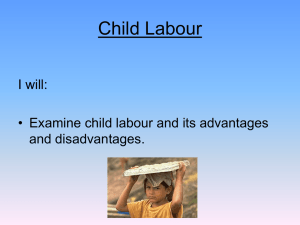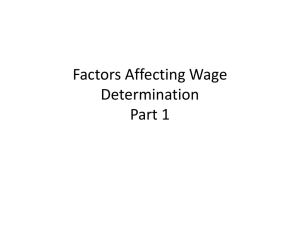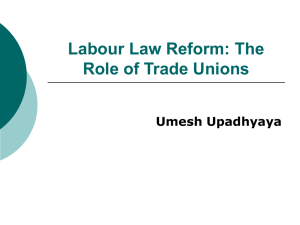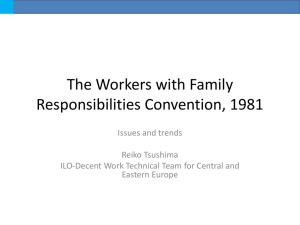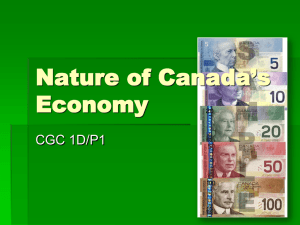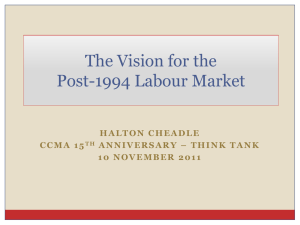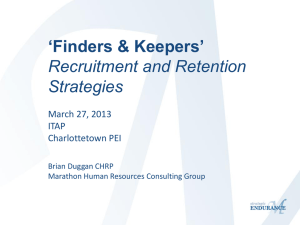Presentation - Professor Sakhela Buhlungu
advertisement
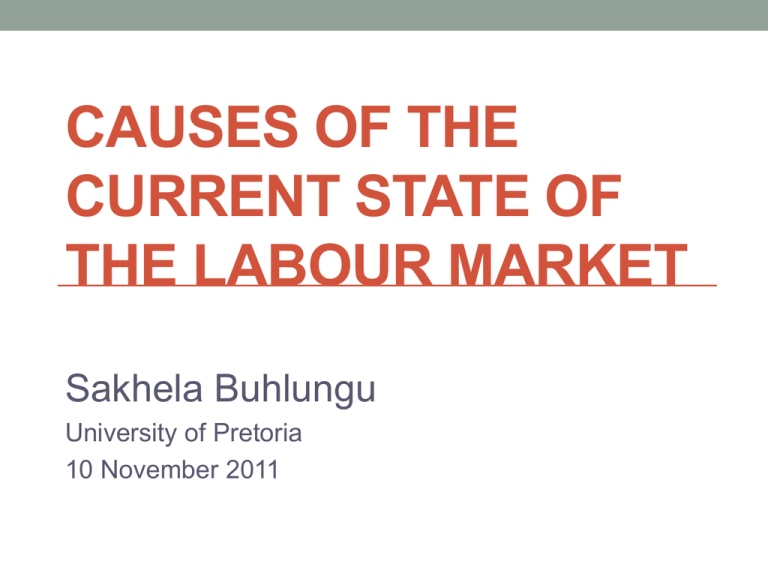
CAUSES OF THE CURRENT STATE OF THE LABOUR MARKET Sakhela Buhlungu University of Pretoria 10 November 2011 FEATURES OF THE LABOUR MARKET • Unemployment • Work restructuring • Labour market flexibility – rhetoric vs reality • Weak skill development regime • Limited progress on employment equity • Legislation & regulation – confusion and weak enforcement • Conflict in industrial relations • Immigration policies and practices not aligned with labour market policies HOW DID WE GET HERE? • Global economic restructuring • The negotiated political transition • Legacy of conflict in society & workplace • ‘Weak’ institutions • Dilemmas facing trade unions • Lack of consensus on shape of labour market • Poor schooling system • Discrimination in the labour market • Confusion around immigration issues GLOBAL ECONOMIC RESTRUCTURING • Market regulation & the ugly face of globalisation • The reality of global competition • Work restructuring – where it hurts the most • Employment flexibility • Workplace - the ‘soft underbelly’ which shows weakness of current representation model • Problems of ‘regulated flexibility’ THE NEGOTIATED POLITICAL TRANSITION • Our labour market reflects the political compromise • Negotiated settlement emphasised continuity, not rupture • Assumption that everyone can look after themselves by forming or using institutions LEGACY OF CONFLICT IN SOCIETY & WORKPLACE • Legacy of conflict in society still with us in all spheres • In workplace & IR the use of power to crush opponents still a dominant approach • Management intransigence • Worker ungovernability (siyayinyova) • The above are often encouraged/celebrated ‘WEAK’ INSTITUTIONS • Capacity to act is often constrained By politics Lack of competence & insufficient knowledge Limited resources Unclear mandate Resistance • Proliferation of weak institutions DILEMMAS FACING TRADE UNIONS • Unions strong & weak at same time • Limited reach & representivity in some sectors • Limited reach in the workplace (eg. technology, restructuring, equity) • The ghost of ungovernability in trade unionism • Problems of fragmentation • Organising young & immigrant workers? LACK OF CONSENSUS ON SHAPE OF LABOUR MARKET • Political/‘ideological’ differences among actors • Government policy based on ‘lowest common denominator’ • Differences and government indecisiveness create gaps for bypassing/flouting of laws POOR SCHOOLING SYSTEM • School education crisis has serious & long term labour market implications • Feeds into massive youth unemployment • Also affects skills development initiatives • Virtually no co-ordination between departments DISCRIMINATION IN THE LABOUR MARKET • Very limited progress • Mainly gender, race, rural, disability • Evidence is there but no meaningful action by relevant institutions • Trade unions show similar paralysis on this CONFUSION ON IMMIGRATION ISSUES • A mixture of protectionism and chaos • Failure to regulate integration of immigrants in labour market results in bypassing of laws & undercutting by employers • Attacks on foreign workers partly driven by fear (real or imagined) of undercutting SOME CONCLUSIONS 1 • Current state of labour market the result of: global forces (that are not all-powerful) Historical and cultural factors Choices made (or not made) by actors and institutions Capacity of institutions and organisations Resources available SOME CONCLUSIONS 2 • Indecisiveness for too long • The features of labour market identified require that choices be made urgently • There is a need for a comprehensive approach that connects the issues • Failing this the labour market will sink even deeper into a state of paralysis and chaos



